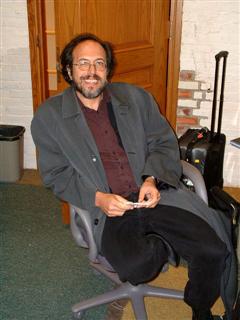Futurists talk about the “Singularity”, the time when computational capacity will surpass the capacity of human intelligence. Ray Kurzweil predicts it will happen in 2045. Therefore, according to its proponents, the world will be amazing then.3 The flaw with such a date estimate, other than the fact that they are always prone to extreme error, is that continuous learning is not yet a part of the foundation. Any AI code lives in the fringes of the software stack and is either proprietary or written by small teams of programmers.
I believe the benefits inherent in the singularity will happen as soon as our software becomes “smart” and we don’t need to wait for any further Moore’s law progress for that to happen. Computers today can do billions of operations per second, like add 123,456,789 and 987,654,321. If you could do that calculation in your head in one second, it would take you 30 years to do the billion that your computer can do in that second.
Even if you don’t think computers have the necessary hardware horsepower today, understand that in many scenarios, the size of the input is the primary driving factor to the processing power required to do the analysis. In image recognition for example, the amount of work required to interpret an image is mostly a function of the size of the image. Each step in the image recognition pipeline, and the processes that take place in our brain, dramatically reduce the amount of data from the previous step. At the beginning of the analysis might be a one million pixel image, requiring 3 million bytes of memory. At the end of the analysis is the data that you are looking at your house, a concept that requires only 10s of bytes to represent. The first step, working on the raw image, requires the most processing power, so therefore it is the image resolution (and frame rate) that set the requirements, values that are trivial to change. No one has shown robust vision recognition software running at any speed, on any sized image!
While a brain is different from a computer in that it does work in parallel, such parallelization only makes it happen faster, it does not change the result. Anything accomplished in our parallel brain could also be accomplished on computers of today, which can do only one thing at a time, but at the rate of billions per second. A 1-gigahertz processor can do 1,000 different operations on a million pieces of data in one second. With such speed, you don’t even need multiple processors! Even so, more parallelism is coming.4
3 His prediction is that the number of computers, times their computational capacity, will surpass the number of humans, times their computational capacity, in 2045. This calculation seems flawed for several reasons:
- We will be swimming in computational capacity long before then. An intelligent agent twice as fast as the previous one is not necessarily more useful.
- Many of the neurons of the brain are not spent on reason, and so shouldn’t be in the calculations.
- Billions of humans are merely subsisting, and are not plugged into the global grid, and so shouldn’t be measured.
- There is no amount of continuous learning built in to today’s software.
Each of these would tend to push Singularity closer and support the argument that the benefits of singularity are not waiting on hardware. Humans make computers smarter, and computers make humans smarter, so this feedback loop is another reason that makes 2045 a meaningless moment in time.
4 Most computers today contain a dual-core CPU and processor folks promise that 10 and more are coming. Intel’s processors also have parallel processing capabilities known as MMX and SSE that is easily adapted to the work of the early stages of any analysis pipeline. Intel would add even more of this parallel processing support if applications put them to better use. Furthermore, graphics cards exist primarily to do work in parallel, and this hardware could be adapted to AI if it is not usable already.
With our growing resources, the Lifeboat Foundation has teamed with the Singularity Hub as Media Sponsors for the 2010 Humanity+ Summit. If you have suggestions on future events that we should sponsor, please contact [email protected].

 The summer 2010 “Humanity+ @ Harvard — The Rise Of The Citizen Scientist” conference is being held, after the inaugural conference in Los Angeles in December 2009, on the East Coast, at Harvard University’s prestigious Science Hall on June 12–13. Futurist, inventor, and author of the NYT bestselling book “The Singularity Is Near”, Ray Kurzweil is going to be keynote speaker of the conference.
The summer 2010 “Humanity+ @ Harvard — The Rise Of The Citizen Scientist” conference is being held, after the inaugural conference in Los Angeles in December 2009, on the East Coast, at Harvard University’s prestigious Science Hall on June 12–13. Futurist, inventor, and author of the NYT bestselling book “The Singularity Is Near”, Ray Kurzweil is going to be keynote speaker of the conference.
 Also speaking at the H+ Summit @ Harvard is Aubrey de Grey, a biomedical gerontologist based in Cambridge, UK, and is the Chief Science Officer of SENS Foundation, a California-based charity dedicated to combating the aging process. His talk, “Hype and anti-hype in academic biogerontology research: a call to action”, will analyze the interplay of over-pessimistic and over-optimistic positions with regards of research and development of cures, and propose solutions to alleviate the negative effects of both.
Also speaking at the H+ Summit @ Harvard is Aubrey de Grey, a biomedical gerontologist based in Cambridge, UK, and is the Chief Science Officer of SENS Foundation, a California-based charity dedicated to combating the aging process. His talk, “Hype and anti-hype in academic biogerontology research: a call to action”, will analyze the interplay of over-pessimistic and over-optimistic positions with regards of research and development of cures, and propose solutions to alleviate the negative effects of both.
The theme is “The Rise Of The Citizen Scientist”, as illustrated in his talk by Alex Lightman, Executive Director of Humanity+:

“Knowledge may be expanding exponentially, but the current rate of civilizational learning and institutional upgrading is still far too slow in the century of peak oil, peak uranium, and ‘peak everything’. Humanity needs to gather vastly more data as part of ever larger and more widespread scientific experiments, and make science and technology flourish in streets, fields, and homes as well as in university and corporate laboratories.”
Humanity+ Summit @ Harvard is an unmissable event for everyone who is interested in the evolution of the rapidly changing human condition, and the impact of accelerating technological change on the daily lives of individuals, and on our society as a whole. Tickets start at only $150, with an additional 50% discount for students registering with the coupon STUDENTDISCOUNT (valid student ID required at the time of admission).
With over 40 speakers, and 50 sessions in two jam packed days, the attendees, and the speakers will have many opportunities to interact, and discuss, complementing the conference with the necessary networking component.
Other speakers already listed on the H+ Summit program page include:
- David Orban, Chairman of Humanity+: “Intelligence Augmentation, Decision Power, And The Emerging Data Sphere”
- Heather Knight, CTO of Humanity+: “Why Robots Need to Spend More Time in the Limelight”
- Andrew Hessel, Co-Chair at Singularity University: “Altered Carbon: The Emerging Biological Diamond Age”
- M. A. Greenstein, Art Center College of Design: “Sparking our Neural Humanity with Neurotech!”
- Michael Smolens, CEO of dotSUB: “Removing language as a barrier to cross cultural communication”
New speakers will be announced in rapid succession, rounding out a schedule that is guaranteed to inform, intrigue, stimulate and provoke, in moving ahead our planetary understanding of the evolution of the human condition!
H+ Summit @ Harvard — The Rise Of The Citizen Scientist
June 12–13, Harvard University
Cambridge, MA
You can register at http://www.eventbrite.com/event/648806598/friendsofhplus/4141206940.
]]>The system NASA uses can be summed up as follows:
TRL 1 Basic principles observed and reported
TRL 2 Technology concept and/or application formulated
TRL 3 Analytical and experimental critical function and/or characteristic proof-of concept
TRL 4 Component and/or breadboard validation in laboratory environment
TRL 5 Component and/or breadboard validation in relevant environment
TRL 6 System/subsystem model or prototype demonstration in a relevant environment (ground or space)
TRL 7 System prototype demonstration in a space environment
TRL 8 Actual system completed and “flight qualified” through test and demonstration (ground or space)
TRL 9 Actual system “flight proven” through successful mission operations.
Progress towards achieving a non-rocket space launch will be facilitated by popular understanding of each of these proposed technologies and their readiness level. This can serve to coordinate more work into those methods that are the most promising. I think it is important to distinguish between options with acceleration levels within the range human safety and those that would be useful only for cargo. Below I have listed some non-rocket space launch methods and my assessment of their technology readiness levels.
Spacegun: 6. The US Navy’s HARP Project launched a projectile to 180 km. With some level of rocket-powered assistance in reaching stable orbit, this method may be feasible for shipments of certain forms of freight.
Spaceplane: 6. Though a spaceplane prototype has been flown, this is not equivalent to an orbital flight. A spaceplane will need significantly more delta-v to reach orbit than a suborbital trajectory requires.
Orbital airship: 2. Though many subsystems have been flown, the problem of atmospheric drag on a full scale orbital airship appears to prevent this kind of architecture from reaching space.
Space Elevator: 3. The concept may be possible, albeit with major technological hurdles at the present time. A counterweight, such as an asteroid, needs to be positioned above geostationary orbit. The material of the elevator cable needs to have a very high tensile strength/mass ratio; no satisfactory material currently exists for this application. The problem of orbital collisions with the elevator has also not been resolved.
Electromagnetic catapult: 4. This structure could be built up the slope of a tall mountain to avoid much of the Earth’s atmosphere. Assuming a small amount of rocket power would be used after a vehicle exits the catapult, no insurmountable technological obstacles stand in the way of this method. The sheer scale of the project makes it difficult to develop the technology past level 4.
Are there any ideas we’re missing here?
]]>I think this argument is not persuasive, since the selection can operate both in the direction of universes with more viable civilizations, and in the direction of universes with a larger number of civilizations, just as biological evolution works to more robust offspring in some species (mammals) and in the larger number of offspring with lower viability (plants, for example, dandelion). Since some parameters for the development of civilizations is extremely difficult to adjust by the basic laws of nature (for example, the chances of nuclear war or a hostile AI), but it is easy to adjust the number of emerging civilizations, it seems to me that the universes, if they replicated with the help of civilizations, will use the strategy of dandelions, but not the strategy of mammals. So it will create many unstable civilization and we are most likely one of them (self indication assumption also help us to think so – see recent post of Katja Grace http://meteuphoric.wordpress.com/2010/03/23/sia-doomsday-the-filter-is-ahead/)
But still some pressure can exist for the preservation of civilization. Namely, if an atomic bomb would be as easy to create as a dynamite – much easier then on Earth (which depends on the quantity of uranium and its chemical and nuclear properties, ie, is determined by the original basic laws of the universe), then the chances of the average survival of civilization would be lower. If Smolin’s hypothesis is correct, then we should encounter insurmountable difficulties in creating nano-robots, microelectronics, needed for strong AI, harmful experiments on accelerators with strangelet (except those that lead to the creation of black holes and new universes), and in several other potentially dangerous technology trends that depend on their success from the basic properties of the universe, which may manifest itself in the peculiarities of its chemistry.
In addition, the evolution of universes by Smolin leads to the fact that civilization should create a black hole as early as possible in the course of its history, leading to replication of universes, because the later it happens, the greater the chances that the civilization will self-destruct before it can create black holes. In addition, the civilization is not required to survive after the moment of “replication” (though survival may be useful for the replication, if civilization creates a lot of black holes during its long existence.) From these two points, it follows that we may underestimate the risks from Hadron Collider in the creation of black holes.
I would repeat: early creation of a black hole suggested by Smolin and destroying the parent civilization, is very consistent with the situation with the Hadron Collider. Collider is a very early opportunity for us to create a black hole, as compared with another opportunity — to become a super-civilization and learn how to connect stars, so that they collapse into black holes. It will take millions of years and the chances to live up to this stage is much smaller. Also collider created black holes may be special, which is requirement for civilization driven replication of universes. However, the creation of black holes in collider with a high probability means the death of our civilization (but not necessarily: black hole could grow extremely slowly in the bowels of the Earth, for example, millions of years, and we have time to leave the Earth, and it depends on the unknown physical conditions.) In doing so, black hole must have some feature that distinguishes it from other holes that arise in our universe, for example, a powerful magnetic field (which exist in collider) or a unique initial mass (also exist in LHC: they will collide ions of gold).
So Smolin’s logic is sound but not proving that our civilization is safe, but in fact proving quiet opposite: that the chances of extinction in near future is high. We are not obliged to participate in the replication of universes suggested by Smolin, if it ever happens, especially if it is tantamount to the death of the parent civilization. If we continue our lives without black holes, it does not change the total number of universes have arisen, as it is infinite.
]]>Technische Universität München
4–6 October 2010
Submission deadline of extended abstracts: 7 May 2010
Submission form
Theme
Historical analysis of a broad range of paradigm shifts in science, biology, history, technology, and in particular in computing technology, suggests an accelerating rate of evolution, however measured. John von Neumann projected that the consequence of this trend may be an “essential singularity in the history of the race beyond which human affairs as we know them could not continue”. This notion of singularity coincides in time and nature with Alan Turing (1950) and Stephen Hawking’s (1998) expectation of machines to exhibit intelligence on a par with to the average human no later than 2050. Irving John Good (1965) and Vernor Vinge (1993) expect the singularity to take the form of an ‘intelligence explosion’, a process in which intelligent machines design ever more intelligent machines. Transhumanists suggest a parallel or alternative, explosive process of improvements in human intelligence. And Alvin Toffler’s Third Wave (1980) forecasts “a collision point in human destiny” the scale of which, in the course of history, is on the par only with the agricultural revolution and the industrial revolution.
We invite submissions describing systematic attempts at understanding the likelihood and nature of these projections. In particular, we welcome papers critically analyzing the following issues from a philosophical, computational, mathematical, scientific and ethical standpoints:
- Claims and evidence to acceleration
- Technological predictions (critical analysis of past and future)
- The nature of an intelligence explosion and its possible outcomes
- The nature of the Technological Singularity and its outcome
- Safe and unsafe artificial general intelligence and preventative measures
- Technological forecasts of computing phenomena and their projected impact
- Beyond the ‘event horizon’ of the Technological Singularity
- The prospects of transhuman breakthroughs and likely timeframes
Amnon H. Eden, School of Computer Science & Electronic Engineering, University of Essex, UK and Center For Inquiry, Amherst NY
]]> Lee Smolin is said to believe (according to personal communication from Danila Medvedev who was told about it by John Smart. I tried to reach Smolin for comments, but failed) that global catastrophe is impossible, based on the following reasoning: the multiverse is dominated by those universes that are able to replicate. This Self-replication occurs in black holes, and in especially in those black holes, which are created civilizations. Thus, the parameters of the universe are selected so that civilization cannot self-destruct before they create black holes. As a result, all physical processes, in which civilization may self-destruct, are closed or highly unlikely. Early version of Smolin’s argument is here: http://en.wikipedia.org/wiki/Lee_Smolin but this early version was refuted in 2004, and so he (probably) added existence of civilization as another condition for cosmic natural selection. Anyway, even if it is not Smolin’s real line of thoughts, it is quite possible line of thoughts.
Lee Smolin is said to believe (according to personal communication from Danila Medvedev who was told about it by John Smart. I tried to reach Smolin for comments, but failed) that global catastrophe is impossible, based on the following reasoning: the multiverse is dominated by those universes that are able to replicate. This Self-replication occurs in black holes, and in especially in those black holes, which are created civilizations. Thus, the parameters of the universe are selected so that civilization cannot self-destruct before they create black holes. As a result, all physical processes, in which civilization may self-destruct, are closed or highly unlikely. Early version of Smolin’s argument is here: http://en.wikipedia.org/wiki/Lee_Smolin but this early version was refuted in 2004, and so he (probably) added existence of civilization as another condition for cosmic natural selection. Anyway, even if it is not Smolin’s real line of thoughts, it is quite possible line of thoughts.